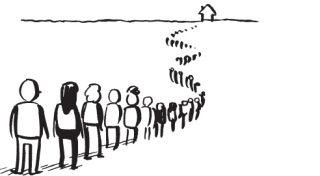Homelessness Taskforce meets to discuss Youth Homelessness Strategy

The Minister for Housing, Local Government and Heritage met with the High Level Homelessness Taskforce in April of this year to discuss the development of the Youth Homelessness Strategy. The High Level Homelessness Taskforce is made up of representatives from the Peter McVerry Trust, Dublin Simon Community, Focus Ireland, Threshold, DePaul, CrossCare and the Dublin Region Homelessness Executive. The Minister highlighted the work being done by Taskforce members in supporting young people experiencing homelessness. The Taskforce will set out the main challenges that lie ahead in addressing the issue of youth homelessness which will feed into the overall Youth Homelessness Strategy.
Youth Homelessness
In April 2021, the Department of Housing, Local Government and Heritage reported that 733 young people aged between 18-24 were officially homeless. They account for 12 per cent of all adults reported as homeless during that period and just over 65 per cent (482) are based in Dublin.
The number of young people experiencing homelessness almost doubled between December 2014 and March 2018 and is currently still 53 per cent higher than the 477 individuals reported in December 2014.
Chart 1: Homelessness, Aged 18 – 24, December 2014 to April 2021
Source: Dept. of Housing, Government and Local Heritage,Homelessness Data,various years.
The Irish Coalition to end Youth Homelessness draws attention to the fact that little is known about these young people and their path to homelessness. They have grouped them into three broad categories whilst acknowledging that there is no information about the numbers or issues faced by each group. The first group are young people who grew up within the care system and despite being in receipt of full welfare payments, are unable to source and secure accommodation. The second group are those with slight or no links to the care system but due to their age are on reduced welfare rates which will not cover the costs associated with independent living. The final group are those young people who are parenting as the head of a family that is homeless.
The figures captured in Chart 1 only reflect those individuals within the system (that is, living in emergency accommodation funded by Section 10 of the Housing Act). However, the internationally recognised ETHOS classification identifies 4 main categories of living situation: Rooflessness, Houselessness, Insecure Housing and Inadequate Housing.[1] Using this classification would capture data on those hidden homeless, the couch surfers relying on friends and family or those living in unsuitable or overcrowded situations. Accurate data gathering would allow for better planning and allocation of resources and should be a priority of any new strategy.
The need for a Youth Homelessness Strategy
Pillar one of the five pillars contained in Rebuilding Ireland, the Action Plan for Housing and Homelessness is Addressing Homelessness. It only mentions homelessness in relation to younger people when committing to “delivering accommodation for vulnerable young care leavers”. This allocation of resources is important as currently 9 per cent of those exiting the care system in Ireland upon reaching the age of 18 are at risk of homelessness.[1] However, it does not address many of the barriers that can be faced by young people in accessing accommodation. Firstly, they are in receipt of reduced welfare rates. At the time of writing, a job seeker claimant aged between 18 and 24 will receive a maximum rate of €112.70 per week.
Secondly, even when in full employment, wages can be low at a time when rents are high. According to a report by FEANTSA, the European Federation of National Organisations working with the Homeless, “In Ireland, average rent in the second quarter of 2020 was EUR 1,256 nationally, and EUR 1,758 in Dublin, against an average income of EUR 1,176 for young people aged 15-24”.[1] Lastly, by virtue of being younger, they will be much lower down the social housing list if they are eligible and may struggle to afford single bed accommodation in the private rental sector even with social housing supports.
Much has been written about the impact of the Covid 19 pandemic restrictions on the job prospects of the young. This in turn impacts on their ability to pay their rent which may result in either homelessness or back living temporarily with friends or family. The focus during the post Covid period must also take into account housing for the young as well as retraining and reskilling opportunities. Lack of security in both work and accommodation can cause disruption to concentration and learning[2] and impacts on the support networks young people need which are important for mental and physical health.[3] Regardless of age, secure, safe, stable, affordable accommodation allows for development across all spectrum and allows for community and family formation. A new Youth Homelessness Strategy must ensure that vulnerable young people do not enter adulthood whilst homeless.
[1] https://www.feantsa.org/download/ethos2484215748748239888.pdf
[2] https://www.researchgate.net/publication/258134750_The_Unique_and_Combin...